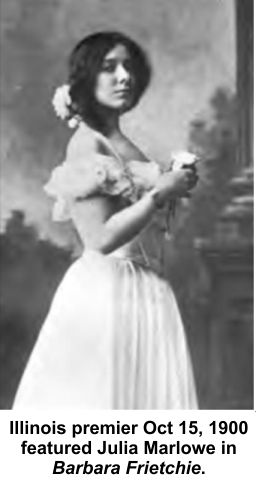|
The
Jackson Street Armory became vacant in 1891 when
the First Regiment Illinois National Guard relocated to its new
Burnham-designed facility on South Michigan Ave.
The owners tried various activities and events in
the building, from weddings to flower shows and a
theater, but by 1900 were ready for a longer term
tenant.
Will J. Davis and Al Hayman
negotiated a ninety-nine-year lease with a sliding
annual rent that reached $15,000 by year three — and
was to remain there until the lease ran out in 1998.
A group of investors paid over a quarter-million
dollars for construction. The lion's share was put up
by the
Klaw & Erlanger corporation with small shares to
Will J. Davis and
Harry Powers. Davis managed the facility
with help from his secretary,
Mary Ellen O'Hagan, who would eventually become
his wife. Davis kept his office at the
Illinois Theater after the Iroquois was in
operation.
The Illinois premier came on October 15, 1900, with
Julia
Marlowe performing in Barbara Frietchie.
Illinois/Iroquois theater manager will J. Davis
would retain an oversized photo of Marlowe for the
rest of his life. He was proud to have a
performer of her stature at the Illinois premier.
She and her second husband, E. H. Sothern, exchanged
Christmas cards and best wishes telegrams with
Davis.
December 30, 1903
The Billionaire was playing
at the Illinois Theatre the week of Dec 30, 1903. It
was a musical farce by Harry B. Smith and Gus Kerker,
starring
Jerome Sykes, Harry Macdonough, John Kennedy,
Walter Percival and Josie Intropodi. Sykes died of
pneumonia the day before the Iroquois fire, Dec 29,
1903, and Iroquois/Illinois theater manager Will J.
Davis was attending Sykes funeral when a messenger
came to tell him the Iroquois Theater was on fire.
Several people in the audience at the Iroquois were
Billionaire cast members, including
two who lost their lives there.
|
 |

There were many common
characteristics between the Illinois and the
Iroquois theaters.
Benjamin Marshall and
Fuller Construction designed and built both.
Labor disputes dogged both during construction.
The decors in both were featured white marble and
brass, the asbestos curtains featured painted scenes
by
St. John Lewis, draperies and color schemes
were provided by the Marshall Field store. A few differences: the Illinois had
more boxes than the Iroquois and the men's smoking
room was finished to look like a rustic cabin,
complete with chinked logs. An abrupt change
of pace from the French Renaissance effects that
dominated the rest of the theater. The Illinois accommodated
twenty-six dressing rooms, two at stage level, the
rest in the basement. The stage, smaller than that
at McVickers, was 46' deep x 70' wide and 84' high.
The Illinois Theater was razed in 1936.
|
|
In 1919 at the death of Will J. Davis, probably accompanying a
floral arrangement, employees at the Illinois who expressed sympathy to the family
included:
|
E. Amigan
F. Armall
N. Briglia
John C.H. Brockman
Sam Budd
E. Cleland
L. Dupani
S. Evanson
H.
Filberman
John Garamoni
|
A. Gennesse
Dan Lareta
J. Levin
Mrs. McHenry
V. Miraglia
R. Nemkovsky
Walter Oakes
H.V. Paulsen
Russi
Thomas J. Ryan
|
A. J. Smith
Bonnie Taylor
George Taylor
Paul Theis
F.E. Timponi
Joseph Turse
Edwin Wappler
Gus Woods
R. M. Zetterible
|
The theater then was running a silent film, The
Betrayal with a thirty-piece orchestra.
|
